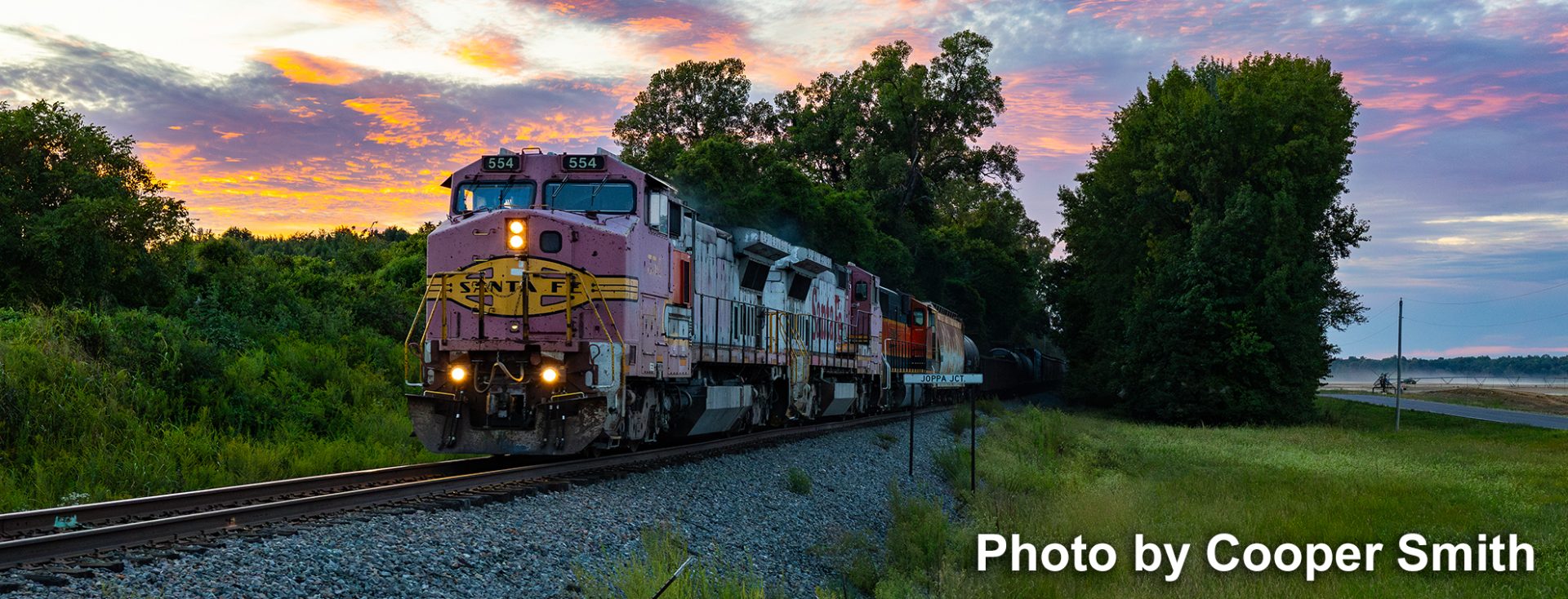
A detouring Lincoln Service train uses the 5-mph connecting track between Metra’s Rock Island District and the St. Charles Airline on June 16, 2007. The raised bridge in the background has been out of service for about 50 years, but demolishing it is too expensive. Bob JohnstonBeneath a blinding headlight, four locomotives advance stiffly along a tight connecting track as
the rails squeal in protest. A dark figure emerges from a pickup truck waiting in the gathering
darkness, swinging a grip onto the lead unit’s pilot before mounting the steps. Throttling up, the
long train accelerates into the night, leaving its usual route behind for the unobstructed trackage of
another railroad. The “dark figure” was a pilot engineer.
Detours are nearly an everyday experience. Wrecks, scheduled maintenance work,
washouts, mudslides — all of these obstacles may cause trains to detour. Although railroads have
a long history of competition, they decided long ago that it made sense to cooperate in times of
crisis. To provide a contractual framework for such cooperation, the American Railway
Association in 1905 adopted a “Standard Form for Detour Agreement” which railroads could sign
to govern emergency operations over each-others lines.
Under the Detour Agreement, the railroad desiring to detour its trains (called the Foreign
Company) notifies the railroad it wants to use (the Home Company) why it needs to detour, what
part of the Home Company’s lines it wants to use, how many trains it wants to detour, “and such
other information as may be required by the Home Company.” The Home Company has complete
discretion to accept or refuse offered detours. As a practical matter, though, railroads rarely refuse
detour movements, because no carrier ever knows when it will need the favor returned.
The Foreign Company assumes all risks of liability arising out of the detour operations. Its
responsibility is absolute, even if the Home Company is clearly at fault. Another cost a detouring
railroad must pay is the trackage-rights charge imposed by the Home Company. Since 1978, the basic charge in the Detour Agreement has been $9 per train-mile. To that charge, the Home
Company adds the cost of crews, fuel, train and engine supplies, repairs, and locomotives provided
to detoured trains.
There’s one operator that isn’t bound by the Detour Agreement — Amtrak. The passenger
carrier has the right, under the Rail Passenger Service Act and its contracts with the major railroads,
to detour trains for incremental costs, meaning the specific cost of operating the detoured train
without any profit element.
Amtrak is also insulated to some degree from the costs of using railroad crews by the
unusually long crew districts it has established for passenger operations. However, Amtrak still
must use railroad pilots when its crews are not qualified to operate over unaccustomed territory
and rent locomotives when its own units can’t read the host railroad’s cab signals.
This article, originally entitled “When trains must leave home,” appeared in the November 1993 issue. [ The above are excerpts from a much longer array. / Source for example below is from the Northern Pacific Railway Historical Association Mainstreeter, Volume 19, No. l, Winter 2000. GOO ]
Addendum: A Real Life Example (with a lot of disappointed railfans)
From 1956 to 1968 the Northern Pacific Railway hosted what was called “Casey Jones Excursions, ” initially using steam hauled vintage passenger cars in Washington state. The NP was uniquely qualified to do this, in that western Washington was full of branch-lines. These excursions were always on Sundays when traffic on those lines was light or non-existent.
Steam locomotives were being sidelined by the industry-wide conversion to diesel, and adequate passenger cars were sitting idled in coach yards. To say that great times were had by all would be an understatement. These excursions were always sold-out. Labor Day 1965, a fully loaded Casey Jones Excursion was heading across the Cascade Mountains destined to the Ellensburg Rodeo, a popular end-of-summer festival. Ahead of them a freight derailed inside the 2-mile Stampede Pass tunnel shutting down the line. The excursion was sidelined in the small mountain town of Lester. The hamlet found its population increased by one-thousand, to the delight of the village grocer and barkeep. The excursion manager immediately began negotiations with the NP dispatcher for a detour rerouting over the Milwaukee Road’s Snoqualmie Pass line. The verdict was no. A detour would have involved returning half way back down the mountain, and trekking on a foreign-lines “less than stellar branch line” to the Milwaukee main-line over Snoqualmie. Having read the detour agreement policy above, it is understandable. These excursions for the most part, paid for themselves, but the railroad was not going to gamble on the potential costs of a derailment on foreign rails. The railway gracefully refunded
the charter money.
Gary O. Ostlund
